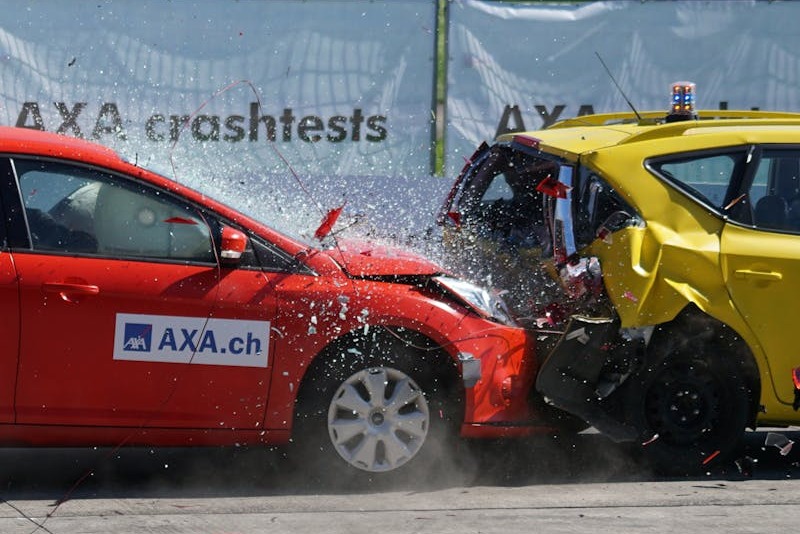Who’s Responsible in a Rear-End Car Accident in Nevada?

One moment, you’re stopped at a red light— the next, you’re rear-ended, shocked, and unsure of what to do next.
In situations like this, everyone—you, the other driver, and the insurance company—wants to know: who’s responsible for the accident? While the answer may seem obvious at first, determining fault in rear-end collisions is often difficult.
Liability in Rear-End Collisions
When you think of a rear-end collision, you probably assume the rear driver is always at fault, right? After all, they’re the ones who crashed into the back of your vehicle. While it’s true that the tailing driver is found liable in most cases, there are exceptions to this rule.
Let’s break down some scenarios where liability might not be so clear-cut:
When the Front Driver May Be at Fault
Imagine you’re driving along the highway when the car in front of you suddenly slams on their brakes for no apparent reason. Despite your best efforts, you can’t stop in time and end up rear-ending them. In this case, the lead driver may be found negligent for making an unexpected and unsafe stop.
Other times, a driver in front might be liable if they:
- Fail to signal before turning or changing lanes
- Have broken brake lights or turn signals
- Suddenly reverse without warning
- Drive erratically or recklessly
When the Rear Driver is at Fault
Most of the time, the rear driver bears responsibility for a rear-end accident. That’s because Nevada law requires drivers to leave enough distance between vehicles to safely stop.
A few common scenarios where the tailing driver is liable:
- Following too closely (tailgating)
- Speeding or driving too fast for conditions
- Distracted driving (texting, eating, etc.)
- Failing to brake in time
If the rear driver violates traffic laws or fails to drive safely, they’ll likely be on the hook for the crash.
When Third Parties Are at Fault
In some cases, rear-end collisions happen due to factors outside of either driver’s control. A few examples:
- A pedestrian darts into the road, causing the front car to brake suddenly
- Another vehicle cuts off the lead car, forcing them to slam on their brakes
- The front car experiences a sudden mechanical failure, like a tire blowout
In these situations, a third party (like that jaywalking pedestrian or the carmaker of a defective vehicle) might bear some or all of the blame.
Evidence to Determine Fault in Rear-End Collisions
Piecing together liability in a rear-end collision is like solving a puzzle. You need evidence to get the full picture. That includes:
- Police accident reports
- Witness statements
- Photos of vehicle damage and the scene
- Surveillance or traffic camera footage
- Vehicle “black box” data
- Cell phone records (to prove distraction)
The more evidence you have, the better case you can build to determine fault and fight for the compensation you deserve. An experienced personal injury lawyer can help gather this critical proof.
Partial Fault and Nevada’s Comparative Negligence Law
Sometimes, both drivers share some blame for the crash. What happens then?
Nevada follows a “modified comparative negligence” rule. Basically, this means:
- If you’re found less than 50% at fault, you can still recover damages. But your award will be reduced by your percentage of fault.
- If you’re 51% or more to blame, you can’t recover anything.
Let’s look at an example. Say you’re rear-ended and suffer $10,000 in damages. But the court finds you 30% at fault because your brake lights were out. Under Nevada comparative negligence, you’d only recover $7,000 (70% of your total damages).
So even if you’re partially liable, you may still have a case. An injury attorney can help assess your role in the accident and fight to get you fair compensation.
Recoverable Damages in a Rear-End Accident
Understanding fault is only part of the equation, though. Once liability is established, the next step is to determine the damages you’re entitled to recover.
Being the victim of a rear-end collision can impact your life physically, emotionally, and financially and the Nevada law allows you to seek damages for things like:
- Medical expenses (hospital bills, prescriptions, therapy, etc.)
- Lost wages from missing work
- Future lost earning capacity if your injuries disable you
- Property damage to your vehicle
- Pain and suffering
- Emotional distress
- Loss of enjoyment of life
The exact damages you can recover depend on the specifics of your crash and the severity of your losses. A knowledgeable personal injury lawyer can calculate the full value of your claim.
Common Injuries in Rear-End Collisions
This brings us to the next part—understanding the injuries that lead to these damages.
Rear-end collisions, even at low speeds, can cause serious harm, while high-speed crashes may result in catastrophic or even fatal injuries. These injuries vary widely depending on the force of impact and the circumstances of the crash.
Some common types of rear-end accident injuries include:
- Whiplash and neck injuries
- Back and spinal cord damage
- Traumatic brain injuries (TBIs)
- Broken bones
- Soft tissue damage
- Lacerations from broken glass or impact
Never brush off pain or assume it will resolve on its own. Always get checked out by a doctor after a rear-end collision. Some injuries have delayed symptoms but get worse over time. Prompt medical care protects both your health and your legal rights.
Your Legal Rights After a Rear-End Collision
Remember, you have rights and options to protect yourself in the aftermath of a rear-end collision. It’s normal to feel unsure or anxious during such a stressful time, but taking informed steps can make all the difference. By understanding your legal options, you can better protect your interests and work toward fair compensation.
Here are a few key things to keep in mind:
- See a doctor as soon as possible to diagnose and document your injuries
- Follow your treatment plan and attend all medical appointments
- Gather evidence from the scene, like photos and witness info
- Avoid posting about your crash or injuries on social media
- Don’t give a recorded statement to the other driver’s insurance company
- Discuss your case with an experienced car accident attorney before accepting any settlement offers
Being proactive about your legal rights can make all the difference in getting the compensation you need to regain your health and rebuild your life.
Final Thoughts on Rear-End Collisions in Nevada
Rear-end collisions are among the most common types of car accidents, but that doesn’t make them any less devastating when they happen to you. It’s important to understand your legal rights and options if you’ve been injured by a negligent driver.
If you want to learn more about your case, you can connect to a skilled car accident attorney from our team at Benjamin Durham Law Firm. With extensive experience handling rear-end accident cases in Nevada, we’ll thoroughly investigate your crash, gather crucial evidence of negligence, deal with insurance companies on your behalf, and fight tirelessly to secure the full compensation you deserve.
Reach out today to start exploring your options. Together, we’ll work to hold the at-fault party accountable and help you get on the road to recovery.



